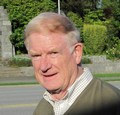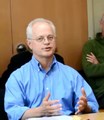AT THE 2009 RESILIENT CITIES CONFERENCE: “To initiate change so that we do business differently means we set the vision based upon community values, support the vision with information and education, provide practical tools, seek partnerships and engage local decision makers,” stated Eric Bonham when he explained Mission Possible

“When we refer to The New Business As Usual, we mean that ‘design with nature’ will be everyday practice; and we will move to an approach that is cohesive, concerted and leads us to sustainability. We are being bold in using the mantra: What do we want Vancouver Island to look like in 50 years? Rather than being guided by 3-year municipal and 4-year provincial government election cycles, we are saying….look 50 years out and backcast to determine what decisions we need to make now to create the future that we want,” stated Eric Bonham.
FLASHBACK TO A WATERSHED MOMENT: At the 2008 Gaining Ground Summit, the CAVI program was the subject of an inter-ministerial announcement made by Dale Wall, Deputy Minister, Ministry of Community Services

“We are using the slogan The New Business As Usual to convey the message that, for change to really occur, practices that until now have been viewed as the exception must become the norm moving forward. We have to build regulatory models and develop models of practice and expertise to support The New Business As Usual. Vancouver Island is the pilot region. The shared vision is to move toward water sustainability by implementing green infrastructure policies and practices. This is a multi-year commitment by the funding agencies,” stated Dale Wall.
Georgia Basin Inter-Regional Education Initiative: Partnership for Water Sustainability updated Regional District of Nanaimo Board (May 2016)

“The Partnership for Water Sustainability brings together, and supports the efforts of, local and regional governments across BC. It’s overarching goal is to provide tools to help organizations achieve their water sustainability goals, and opportunities for shared learning. The IREI is an outstanding example of this shared learning approach, and is endorsed by 5 Regional Boards, representing 75% of the population in BC,” stated Randy Alexander.
Convening for Action: The ‘regional team approach’ is founded on partnerships and collaboration; and seeks to align actions at three scales – provincial, regional and local

“The major outcome from the Learning Lunch Seminar Series has been the demonstrated effectiveness of the regional team approach, a model that has broad application potential throughout Vancouver Island and beyond. It demonstrates that when the parties reach for a common vision and work through their jurisdictional differences it is possible to accomplish mutual goals and implement sustainable practices within an overriding watershed context,” stated Eric Bonham.
FLASHBACK TO 2008: Eric Bonham explained the CAVI mission when he co-presented the “Year One Progress Report” at Ministry of Environment Workshop (video)

The Ministry of Environment included a progress report on CAVI-Convening for Action on Vancouver Island at the Ministry’s second annual ‘water workshop’, held in Nanaimo. “We took ourselves up and down the island. We asked the same question: What will Vancouver Island look like in 50 years? There was a sense of urgency. We wanted to talk about and establish some way of collaborating on Vancouver Island. We found that the north is not talking to the south, and the east is not talking to the west. So, we said why don’t we pull these people together,” stated Eric Bonham.
Georgia Basin IREI introduced to Environmental Managers Association of BC (April 2016)

“Restoring the absorbency of the urban landscape would reduce demand for landscape irrigation water and sustain environmental flows during droughts. It would also reduce stream erosion in wet weather,” stated Kim Stephens. ”Too often people think of land and water as being independent – almost like silos. But what we do on the land, and whether we treat the land with respect, has direct implications and consequences for water use.”
Georgia Basin IREI introduced to civil engineering graduates of BCIT (March 2016)

“The presentation by Kim Stephens gave further insight into how thinking has evolved regarding stormwater management in our region and elsewhere. His discussion of Voodoo Hydrology reinforced the importance of questioning everything, a habit I try to encourage in my students,” stated Laith Furatian. The term was coined by Andy Reese, an American engineer and writer, in 2006 to describe the mis-application of science.
Georgia Basin IREI introduced to Delta’s Mayor and Council (Dec 2015)

“It is evident that there are many champions in local government; and it is important that we recognize and celebrate what they are doing. This is all part of creating our future. And when we ask ‘what will this community look like in 50 years’, we can point to the green infrastructure examples and then we will know what it will look like in 50 years,” stated Mayor Lois Jackson.
Georgia Basin Inter-Regional Education Initiative: Partnership's Kim Stephens introduced CRD Environmental Services Committee to "Beyond the Guidebook 2015"

The Capital Regional District has undergone a transition, from ‘stormwater-based thinking’ that is narrowly focussed, to ‘watershed-based thinking’ that is holistic in approach. Judy Brownoff, Chair of the Environmental Committee, welcomed Kim Stephens and invited him to update the members about the CRD chapter in Beyond the Guidebook 2015. CRD experience shows that local governments can foster a new ‘Land Ethic’ through Integrated Watershed Management Strategies.
5-YEAR FLASHBACK TO 2011: Vision for implementing Sustainable Service Delivery in the Comox Valley introduced at "CAVI Forum within Vancouver Island Summit"

“So, to promote a holistic approach to infrastructure asset management, we have crystallized three key objectives for Sustainable Service Delivery: 1) pay down the legacy cost of existing hard infrastructure; 2) reduce the life-cycle cost of new hard infrastructure; and, 3) shift from gray to green to protect downstream values (i.e. environmental and/or agriculture),” stated Kevin Lagan, former Director of Operational Services with the City of Courtenay, in 2011.

